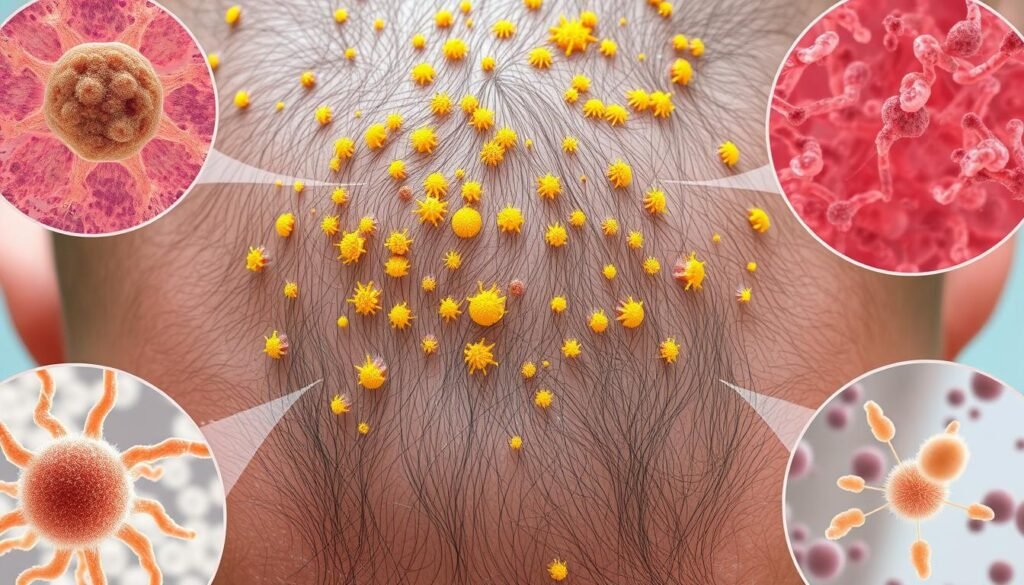About 5% of adults and 10% of infants experience seborrhoeic dermatitis. This makes it a common scalp problem worldwide. It shows up mostly on the scalp, face, and torso as oily patches and dandruff. Even though it’s uncomfortable, it’s usually not contagious and doesn’t cause permanent hair loss.
This condition can get better on its own. Yet, knowing why seborrhoeic dermatitis happens is key to managing it. It can come and go, triggered by things like fungal overgrowth, hormone changes, and lifestyle habits. We’ll dive into what causes this condition and offer insights for those looking for relief.
Key Takeaways
- Seborrhoeic dermatitis is a common scalp condition affecting both adults and infants.
- It typically manifests as oily patches and dandruff due to various triggers.
- Understanding the causes seborrhoeic dermatitis can help manage symptoms effectively.
- The condition may resolve on its own but can require treatment in persistent cases.
- Factors such as fungal overgrowth and lifestyle choices play a significant role in flare-ups.
Introduction to Seborrhoeic Dermatitis
Seborrhoeic dermatitis is a common skin condition affecting areas with oil, like the scalp, face, and ears. It leads to scaly patches, red skin, and stubborn dandruff. This skin issue can start in both babies and adults, typically showing up in either young adulthood or after 50. It is seen in about 3 to 10 people out of 100, with men more commonly affected than women.
The symptoms can range from mild to severe and often come and go. This makes it a chronic issue for many. Stress, lack of sleep, the change of seasons, and certain health problems can trigger it. Conditions such as Parkinson’s disease, depression, and HIV are also risk factors.
Some might find the condition goes away on its own, showing the importance of understanding how to manage it. An early look at the symptoms can lead to better treatment. For more info, check this overview.
What is Seborrhoeic Dermatitis?
Seborrhoeic dermatitis is a long-term skin problem. It causes red, greasy areas with flaky scales. The most common spots it affects are oily parts of the body. This includes the scalp, face, sides of the nose, eyebrows, ears, and chest.
People with seborrhoeic dermatitis often feel itchy. They see scaly patches with yellow or white flakes. Stress, tiredness, and weather changes can make it worse. However, it’s not contagious and won’t cause permanent hair loss.
This condition starts in infancy or adolescence but can also appear in adults over 30. It’s more prevalent among Black people and more common in men than women. Although there’s no cure, treatments can help reduce symptoms and make the skin look better.
Treatment can include over-the-counter and prescription options. They vary by individual needs. For more about seborrhoeic dermatitis, check out this resource.
| Symptom | Description |
|---|---|
| Itchiness | Often intense, contributing to discomfort. |
| Flaking skin | Commonly recognized as dandruff. |
| Scaly patches | Developed in oily areas with yellow or white scales. |
| Inflamed skin | Can lead to redness and irritation. |
Causes of Seborrhoeic Dermatitis
Seborrhoeic dermatitis comes from different factors that deeply affect people. Knowing these factors helps in controlling the symptoms. Two main causes are fungal growth and how much oil the skin makes.
Understanding Fungal Overgrowth
The main cause of seborrhoeic dermatitis is the Malassezia yeast on the skin. When too much of this fungus grows, it makes the skin inflamed. This leads to the common signs of the condition.
Many people with oily skin face more fungus problems. This fact helps us see how a slight imbalance can lead to bigger issues.
The Role of Oil Production
Having more oil on the skin plays a big role in getting seborrheic dermatitis. People with oily skin suffer more from this condition. Too much oil gives fungus a better place to grow, making the problem worse.
Changes in hormones and some health issues can make skin oilier. This makes the symptoms of seborrheic dermatitis even worse. Controlling oil is key in treatments that aim for healthier skin.

Hormonal Imbalances and Their Impact
Hormonal changes are crucial in how severe seborrhoeic dermatitis gets. Stages like puberty, pregnancy, and menopause can cause hormone shifts, triggering symptoms. During puberty, increased androgens such as testosterone and DHEA raise scalp oil production. This is a key trigger for seborrhoeic dermatitis.
Men are more often affected than women. This fact hints that testosterone plays a role in seborrhoeic dermatitis. Research indicates the highest rates are in teenagers and folks 30 to 60 years old. The symptoms tend to lessen after 60. Both too much and too little hormones can make flare-ups more likely.
Flare-ups in women might happen with their menstrual cycle or during menopause when there’s less estrogen. Estrogen affects Malassezia yeast growth, which is related to seborrhoeic dermatitis. Some hormonal birth control options, which include estrogen, could help by lessening sebum production.
For those with big hormonal changes, hormonal therapy might be a good way to control hormone levels and manage symptoms better. Knowing about these hormonal changes can help people foresee flare-ups and take steps to prevent them.

| Factor | Impact on Seborrhoeic Dermatitis |
|---|---|
| Testosterone Levels | Elevated levels contribute to increased oil production. |
| Estrogen Levels | Low estrogen can trigger flare-ups, especially in women. |
| DHEA | Imbalances can enhance susceptibility to symptoms. |
| Hormonal Birth Control | May help reduce sebum production and manage symptoms. |
| Hormonal Therapy | Can regulate levels in individuals facing severe symptoms. |
Immune System Dysfunction: A Contributing Factor
It’s important to understand how a weak immune system affects seborrhoeic dermatitis. If your immune system is not strong, you may suffer more from this skin issue. This is because your body has a hard time dealing with yeast and inflammation.
Knowing the impact of immune health on this condition is key. It helps in managing the disease better.
How Stress Affects the Condition
Stress is a big problem for people with seborrhoeic dermatitis. When stressed, our immune system can’t fight off the skin problem well. This leads to worse flare-ups.
Learning to manage stress is essential. Techniques like deep breathing and mindfulness help. They can make symptoms less severe and improve your life quality.

| Factors | Impact on Seborrhoeic Dermatitis |
|---|---|
| Immune System Dysfunction | Increased severity of symptoms due to inability to regulate yeast and inflammation |
| Stress | Weakens immune response, leading to more frequent flare-ups |
| Management Techniques | Practices like meditation and regular exercise can reduce stress and improve skin condition |
The Influence of Genetics on Seborrhoeic Dermatitis
Research shows that genetic factors play a big role in getting seborrhoeic dermatitis. If your family has a history of skin issues, like atopic dermatitis, your risk goes up. It’s important to know about these genes because they can make certain skin types more likely to get this condition.
Many studies have looked at different genes in people with seborrhoeic dermatitis. They found big changes in these genes compared to healthy people. These changes show that genetics does more than just increase risk. It also affects how the body’s immune system responds to the condition.
There’s also evidence that genes affect the skin’s barrier. Issues with certain genes linked to skin tightness and lipid metabolism show that genes and environment work together. By understanding these genetic factors, doctors can better manage seborrhoeic dermatitis. This understanding helps in creating personalized treatments based on a person’s genetic makeup.
Environmental Factors That Trigger Flare-Ups
Environmental elements significantly influence seborrhoeic dermatitis flare-ups. Different things in our surroundings can make this condition worse. Knowing what these triggers are helps people take steps to keep their skin healthy, especially when the seasons change.
Impact of Seasonal Changes
Seasons greatly affect seborrhoeic dermatitis symptoms. In cold, dry weather, skin loses moisture, making irritation and flare-ups more likely. Meanwhile, high humidity encourages yeast and fungi to grow, making things worse. Understanding these triggers is key to managing symptoms well.
- Cold weather can cause skin dryness.
- Extreme heat may lead to increased oil production, potentially worsening the condition.
- Seasonal allergies can trigger or aggravate symptoms.
- Humidity can foster the conditions for fungal overgrowth.
People should tailor their skincare to the season to fight flare-ups. Adding moisture in winter and controlling oil in summer are good strategies. For tips on scalp care, visit this resource.
| Season | Potential Triggers | Management Tips |
|---|---|---|
| Winter | Cold, dry air | Use moisturizers and humidifiers |
| Summer | High humidity | Opt for lightweight, antifungal products |
| Spring | Allergens | Employ allergy management techniques |
| Fall | Dry air and temperature shifts | Increase moisture intake and adjust skincare |
Understanding seborrhoeic dermatitis triggers and adjusting skincare can greatly reduce flare-ups all year.
Lifestyle Habits That Contribute to Seborrhoeic Dermatitis
To manage seborrhoeic dermatitis, knowing how lifestyle habits affect it is key. Keeping clean and eating right helps ease or worsen symptoms.
Proper Hygiene Practices
Regular cleaning is essential for healthy skin and scalp. Using the right gentle products helps keep the scalp balanced. This avoids too much oil, which can cause outbreaks.
Dermatologists suggest anti-yeast or antifungal shampoos a few times weekly. These shampoos lower malassezia fungus and ease itching and redness.
Dietary Triggers and Their Effects
The link between diet and seborrhoeic dermatitis is clear. Eating lots of sugar, bad fats, and some processed foods can cause inflammation. This boosts the chance of getting flare-ups.
Studies found that eating white bread, rice, and some fruits leads to more cases of the condition.
| Food Type | Association with Seborrhoeic Dermatitis |
|---|---|
| Spicy Foods | 16.9% reported flare-ups |
| Sweets | 16.9% reported flare-ups |
| Fried Foods | 13.5% reported flare-ups |
| Dairy Products | 11.9% reported flare-ups |
| Citrus Fruits | 10.2% reported flare-ups |
| Improving Foods | Citrus and leafy greens reduce symptoms |
Choosing healthier foods while keeping clean can greatly help with seborrhoeic dermatitis. For effective treatment or advice, consult a healthcare provider. They can offer help that suits your needs.
Conclusion
It’s key to know what causes seborrhoeic dermatitis if you want to manage it well. Between 1 to 5 percent of adults are affected, with a higher risk in people with weaker immune systems. Understanding what triggers this condition is essential. Hormonal changes, stress, and the environment can all make symptoms worse. By being aware, you can handle these flare-ups better.
To tackle seborrhoeic dermatitis, creating a care plan is a smart move. This might include using treatments like ketoconazole shampoo, which is effective. Good hygiene and knowing which foods to avoid are also crucial. Changing these habits can decrease the chance of flare-ups and help keep your skin healthy.
For those dealing with seborrhoeic dermatitis, learning more about it is beneficial. Knowledge is powerful for managing symptoms and improving life quality. Being informed can lead to better ways to ease discomfort and promote well-being.